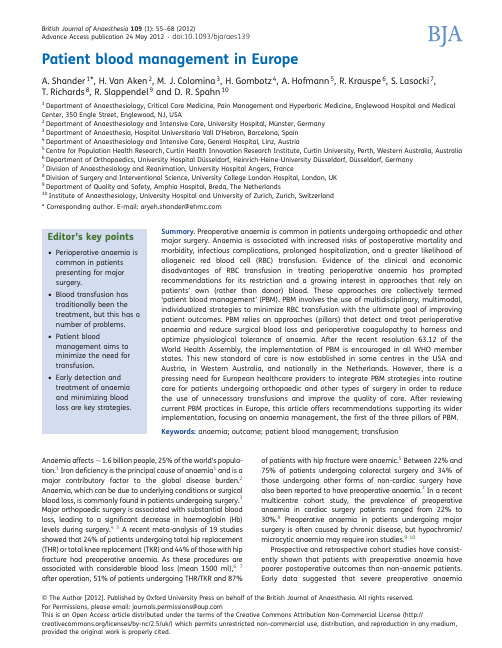欧洲麻醉学会(ESA)围手术期严重出血管理指南
严重创伤出血和凝血病处理-欧洲指南

及时识别出血对于挽救患者生 命至关重要。
对于疑似出血的患者,应立即 进行基础生命支持,包括保持 呼吸道通畅、建立静脉通道和 给予适当剂量的液体复苏。
出血的处理
01 总结词
控制出血是减少失血和改善患 者预后的关键。
02
详细描述
一旦识别出血,应立即采取措 施控制出血,包括使用止血带 、加压包扎、填塞等止血技术 ,以及手术止血。同时,应尽 快将患者转运至医疗机构进行 进一步治疗。
04
增强医护人员的团队协 作和沟通协调能力。
培训内容
诊断标准和评估方 法。
凝血病的治疗和管 理。
严重创伤出血和凝 血病的病理生理机 制。
紧急止血技术和方 法。
团队协作和紧急情 况下的沟通协调。
教育材料和资源
01
02
03
04
欧洲严重创伤出血和凝血病处 理指南。
国际创伤生命支持组织(ITLS) 的培训教材和课程。
严重创伤出血和凝血病处理-欧 洲指南
目录
CONTENTS
• 引言 • 严重创伤出血的识别和处理 • 凝血病的识别和处理 • 严重创伤出血和凝血病处理的优先顺序 • 严重创伤出血和凝血病处理的资源与设备 • 严重创伤出血和凝血病处理的培训和教育
01 引言
CHAPTER
目的和背景
目的
本指南旨在为欧洲地区的医疗工作者提供关于严重创伤出血 和凝血病处理的指导原则,以优化患者的治疗效果和生存率 。
03 凝血病的识别和处理
CHAPTER
凝血病的识别
01
02
03
凝血病症状
包括皮肤黏膜出血、伤口 血流不止、皮下瘀斑等。
实验室检查
通过检测血小板计数、凝 血酶原时间、活化部分凝 血活酶时间等指标,判断 凝血功能是否正常。
13. (中文)2013欧洲麻醉学会(ESA)围手术期严重出血管理指南

ESA发布围术期严重出血管理指南欧洲麻醉学会(ESA)近期发布了“围手术期严重出血管理指南”,旨在对现有证据进行评估,为临床应用提供建议。
欧洲麻醉学会(ESA)近期发布了“围术期严重出血管理指南”,旨在对现有证据进行评估,为临床应用提供参考,相关内容发表在2013年6月出版的《欧洲麻醉学杂志》(EurAnaesthesiol)上。
过去20年间,关于围术期输血策略的研究证据显著增加。
这些证据不仅反映了输血医学的复杂性,也体现了输血替代方法的发展,以及建立在循证医学基础上围术期输血实践的巨大进步。
因此,迫切需要更新输血指南,以使医务工作者与时俱进地利用研究证据。
ESA指南工作组通过3种方法对已发表的相关文献进行检索。
① 2010年12月,ESA指南工作组采用“麻醉”、“手术”、“出血”等术语对MEDLINE和荷兰医学文献数据库(Embase)近10年来发表的相关数据进行了检索。
② 2011年5月至2012年5月,针对需要较多数据的研究领域,对MEDLINE和Embase进行了更详细的检索。
③对麻醉干预的系统综述进行了更广泛的检索。
共纳入2 686篇文献。
采用评估、进展和评价分级系统(GRADE)制定了“围术期严重出血管理指南”。
该指南旨在对现有证据进行评估,为临床应用提供建议,指导临床医师采用安全、具成本效益的策略,最大限度减少围术期严重出血及保存血液。
该指南的主要内容包括:通过了解患者情况和实验室检查,鉴别围术期出血风险增加的患者;采取策略,纠正术前贫血及微循环和大循环(macrocirculation)失衡,优化患者对出血的耐受程度;采取恰当的促凝干预策略,以减少出血量,降低发病率和死亡率,减少医疗费用。
该指南主要就以下方面提出了建议:凝血状况评估该指南建议,在进行手术或有创操作之前,使用结构化的患者访视法或问卷法了解患者的出血史、家族出血史及详细用药史(1C)。
该指南建议,对于择期手术,与进行常规凝血试验[活化部分凝血活酶时间(APTT)、凝血酶原时间(PT)和血小板计数]相比,通过标准化调查问卷了解患者的出血史和用药史更可取(1C)。
ESCESA 非心脏手术心血管疾病评估及防治最新指南(全文)

ESC/ESA 非心脏手术心血管疾病评估及防治最新指南(全文)欧洲心脏病学会(ESC)与欧洲麻醉学会(ESA)联合发布了非心脏手术中心血管疾病(CVD)的评估及防治的最新指南。
该指南汇集当今欧洲医学界非心脏手术方面的最新进展,同时继承了已往指南的合理内容, 是为内科及相关医师对进行非心脏手术的患者术前、围手术期及术后管理制定。
以下为ESC/ESA 非心脏手术CVD 评估及防治最新指南要点概述,指南对治疗的建议以国际通用方式表示:建议分类:I级推荐某种治疗或措施已证实和(或)一致公认有益、有用和有效;II级推荐某种治疗或措施的有用性和有效性的证据尚有矛盾或存在不同的观点;IIa级推荐有关证据和(或)观点倾向于有用和(或)有效;IIb级推荐有关证据和(或)观点不能充分说明有用和(或)有效;III级推荐已经证实和(或)一致公认某诊疗措施无用和无效,并在有些病例可能有害。
证据级别:A级证据数据来源于多项随机临床试验或荟萃分析。
B级证据数据来源于单项随机临床试验或大型非随机化研究。
C级证据专家共识和/或小型研究、回顾性研究、注册研究。
一、新指南简介:ESC/ESA 在新指南指出了当前非心脏手术中CVD 并发症带来的治疗损失,而且统计结果显示随着欧洲老龄化等问题日趋严重,非心脏手术CVD 并发症比例也相应升高。
围手术期并发症的风险取决于患者术前的状况、合并症的情况、外科手术的紧迫性、手术大小、类型及持续时间。
更具体地说,下列患者心脏并发症的风险升高:明确诊断或无症状的缺血性心脏病(IHD)、左室功能不全、心脏瓣膜病((VHD) 、心律失常,以及既往经历较长时间血液动力学及心脏负荷异常状态外科手术患者。
指南指出老龄化自身对于非心脏手术CVD 并发症的影响较小,急症或重症心脏、肺部及肾脏疾病与CVD 并发症风险率关联性更为显著。
因此,以上因素也应纳入CVD 并发症的评估指标。
二、术前评估为了减少围手术期心脏并发症风险,手术前询问患者疾病史并进行心脏评估必不可少。
ESCESA非心脏手术心血管疾病评估及防治最新指南(全文)

ESC/ESA非心脏手术心血管疾病评估及防治最新指南(全文)欧洲心脏病学会(ESC)与欧洲麻醉学会(ESA )联合发布了非心脏手术中心血管疾病(CVD )的评估及防治的最新指南。
该指南汇集当今欧洲医学界非心脏手术方面的最新进展,同时继承了已往指南的合理内容,是为内科及相关医师对进行非心脏手术的患者术前、围手术期及术后管理制定。
以下为ESC/ESA非心脏手术CVD评估及防治最新指南要点概述,指南对治疗的建议以国际通用方式表示:建议分类:I级推荐某种治疗或措施已证实和(或)—致公认有益、有用和有效;II级推荐某种治疗或措施的有用性和有效性的证据尚有矛盾或存在不同的观点;Ha级推荐有关证据和(或)观点倾向于有用和(或)有效;Hb级推荐有关证据和(或)观点不能充分说明有用和(或)有效;III级推荐已经证实和(或)—致公认某诊疗措施无用和无效,并在有些病例可能有害。
证据级别:A级证据数据来源于多项随机临床试验或荟萃分析。
B级证据数据来源于单项随机临床试验或大型非随机化研究。
C级证据专家共识和/或小型硏究、回顾性研究、注册硏究。
一、新指南简介:ESC/ESA在新指南指出了当前非心脏手术中CVD并发症带来的治疗损失,而且统计结果显示随着欧洲老龄化等问题日趋严重,非心脏手术CVD并发症比例也相应升高。
围手术期并发症的风险取决于患者术前的状况、合并症的情况、外科手术的紧迫性、手术大小、类型及持续时间。
更具体地说,下列患者心脏并发症的风险升高:明确诊断或无症状的缺血性心脏病(IHD)、左室功能不全、心脏瓣膜病((VHD)、心律失常,以及既往经历较长时间血液动力学及心脏负荷异常状态外科手术患者。
指南指出老龄化自身对于非心脏手术CVD并发症的影响较小,急症或重症心脏、肺部及肾脏疾病与CVD并发症风险率关联性更为显著。
因此,以上因素也应纳入CVD并发症的评估指标。
二、术前评估为了减少围手术期心脏并发症风险,手术前询问患者疾病史并进行心脏评估必不可少。
严重创伤大出血的早期处理欧洲指南解读

fluid and hypothermia
bleeding
and coagulation
严重创伤大出血的早期处理欧洲指南解读
VI.Treatment pathway
第11页
二、早期复苏和预防深入出血
严重创伤大出血的早期处理欧洲指南解读
第12页
• R1: 对于需要紧急外科手术止血患者, 应尽可能缩短受伤至手 术时间(1A)
一旦出现凝血紊乱马上中止使用HES。
严重创伤大出血的早期处理欧洲指南解读
/BiologicsBloodVaccines40
第39页
• R14.5: 对于钝性伤和颅脑损伤患者,提议在早期能够使用 高渗溶液, 但与晶体液和胶体液相比并无显著优势(2B)
严重创伤大出血的早期处理欧洲指南解读
第6页
创伤性凝血病对预后有着主要影响
严重创伤大出血的早期处理欧洲指南解读
Injury, Int.J.Care Injured () 38, 298—304
第7页
入院时有凝血功效异常创伤患者死亡率增加4~6倍
严重创伤大出血的早期处理欧洲指南解读
Niles SE, et al.J Trauma, , 64(6): 1459-1463.
Cochrane Database Syst Rev. Mar 16;(3):CD000567
第40页
• R14.6: 对于血流动力学不稳定躯干穿透伤患者, 推荐使用高渗液体(2C)
Conclusion:
For patients with penetrating injuries to the torso that result in hypotension, initial fluid resuscitation with HSD is beneficial in improving survival, especially if surgery is subsequently required.
严重创伤出血和凝血病处理欧洲指南

凝血酶原复合物进行紧急拮抗(1A); 为减轻使用新型口服抗凝剂的患者发生创伤后致命性出血,建议给予
PCC(2c); 如果纤维蛋白原水平正常,建议如果血栓弹力图监测提示凝血启动延
迟时使用PCC或血浆(2C)。
同时联合使用大剂量(25-50U/Kg)PCC、直到出现特异性拮抗剂(2C)。
6.10 直接口服抗凝药—凝血酶抑制剂 推荐 35:建议对于正在服用或可疑服用达比加群药物的与 APTT 对达比加群作定性估计(2C) 如果出现致命性出血,推荐 idarucizumab(5g,iv) (1B),或者如果没有
7.1 指南执行 推荐38:每家医疗机构对创伤出血患者实施具有循证医学
依据的临床指南。(1B) 7.2 出血控制与预后的评估 推荐 39:当地的临床质量与安全管理系统应该包括评估
出血控制与结局关键指标的参数(1C)。
严重创伤出血和凝血病处理欧洲指南
6.12 血栓预防 推荐 37:推荐出血控制后 24h 内使用药物预防血栓(1B); 建议尽早采用物理措施预防深静脉血栓,包括间歇性气囊加压装置
(1C)、抗血栓弹力袜(2C); 不推荐常规使用下腔静脉滤器进行血栓预防(1C)。
严重创伤出血和凝血病处理欧洲指南
七、指南执行与质量控制
严重创伤出血和凝血病处理欧洲指南
首剂1 g(至少10 min),后续1 g输注至少持续8 h(1A); 创伤出血患者应该在伤后3 h内使用氨甲环酸(1B); 建议制定创伤出血处理流程时,考虑在患者转送医院的途中应用首剂
的氨甲环酸(2c)。
严重创伤出血和凝血病处理欧洲指南
六、进一步复苏
严重创伤出血和凝血病处理欧洲指南
2023年欧洲指南:严重创伤出血和凝血障碍的管理(第6版)39项推荐

2023年欧洲指南:严重创伤出血和凝血障碍的管理(第6版)39项推荐1 早期复苏与防止再出血缩短间隔时间推荐1建议将严重创伤患者直接送往合适的创伤医疗中心进行救治(1B)尽量缩短创伤出现到出血控制的时间间隔(1B)局部出血管理推荐2建议局部按压以限制危及生命的出血(1B)在术前使用止血带来阻止开放性四肢损伤导致的危及生命的出血(1B)通气推荐3建议在存在气道阻塞、意识改变[格拉斯哥昏迷指数( GCS )≤8分]、低通气或低氧血症的情况下,立即进行气管插管或替代气道管理(1B)建议避免出现低氧血症(1A)建议避免高氧血症,除非存在即将出血的情况(2B)建议对创伤患者行正常通气(1B)建议对于存在脑疝迹象的创伤患者采取的救命措施-过度通气(2C)院前血液制品使用推荐4对院前血液制品的使用没有明确的赞成或反对的建议或意见2 出血的诊断与监测早期评估推荐5建议临床医生结合患者生理、损伤解剖类别、损伤机制和患者对初始复苏的反应来评估创伤性出血的程度(1C)建议使用休克指数(shock index,SI)来评估低血容量休克的严重程度和输血需求(1C)紧急干预推荐6建议有明显出血源、出现肢体失血性休克和疑似出血源的患者进行紧急止血(1 B)进一步检查推荐7建议对不明原因出血及不需要紧急止血的患者,立即进行进一步检查以确定出血源(1C)影像学检查推荐8建议,在可行且在不耽误转运的情况下,使用院前超声检查(PHUS)检测胸腹部损伤患者是否存在血/气胸、心包积血和/或腹腔游离积液(2B)建议对胸腹损伤患者使用包括FAST在内的床旁超声检查(POCUS)(1C)建议早期使用增强全身CT( WBCT ) 来检测和识别损伤类型及潜在的出血源(1 B)血红蛋白推荐9建议将重复Hb和/或Hct测定作为出血评估的实验室指标,因为正常范围内的初始值可能会掩盖早期出血表现(1B)血清乳酸盐和碱缺失推荐10建议将血乳酸作为估计和监测出血和组织低灌注程度的敏感指标,在没有乳酸测量的情况下,碱基缺失可能是一个合适的替代方案(1B)凝血功能监测推荐11建议采用传统的实验室方法( 凝血酶原时间( PT ) /国际标准化比值( INR )、Clauss纤维蛋白原水平和血小板计数和/或即时检验( POC ) PT / INR和/或黏弹性试验( viscoelastic method) ,进行早期、重复监测凝血功能(1C)血小板功能监测推荐12对于正在接受抗血小板治疗或疑似血小板功能异常的创伤患者,建议避免常规使用血小板功能床旁快速检测装置(point ofcare,POC)进行血小板功能监测(1C)3 组织氧合、容量、液体类型和体温容量置换和目标血压推荐13在创伤后的初始阶段,建议使用限制性容量置换以达到目标血压,目标收缩压为80~90 mmHg(平均动脉压为50~60 mmHg),直至严重出血得到控制且无颅脑损伤的临床指征(1B)建议严重创伤性脑损伤(traumatic brain injuries,TBI)(GCS≤8分)患者的平均动脉压维持在80mmHg以上(1C)血管升压药和强心药推荐14如果限制性容量替代策略未达到目标血压,我们建议在输注液体的同时给予去甲肾上腺素以维持目标动脉压(1C)建议在存在心肌功能障碍的情况下输注多巴酚丁胺(1C)液体类型推荐15建议对低血压性创伤出血患者开始使用0.9 %氯化钠或平衡晶体溶液进行液体治疗(1B)对于严重颅脑外伤患者避免使用低渗晶体溶液如乳酸林格液(1B)由于胶体对凝血功能的不良影响,建议限用胶体液(1C)红细胞水平推荐16若需红细胞输注,建议目标血红蛋白为70~90 g/L(1C)自体血回输推荐17建议在出现腹腔、盆腔或胸腔严重出血时考虑行自体血回输(2B)体温管理推荐18尽早采取措施减少热量散失,复温低体温患者,恢复和维持正常体温(1C)4 快速控制出血损伤控制性手术推荐19对于以失血性休克、持续出血、凝血功能障碍和/或合并腹部血管和胰腺损伤为临床表现的严重创伤患者,推荐损伤控制性手术(1B)应采取损伤控制性手术其他原因包括体温过低、酸中毒、难以触及的重大解剖损伤、长耗时的手术的严重创伤(1C)对于不存在上述任何情况的患者,建议进行初级确定性的外科手术治疗(1C)骨盆闭合和稳定推荐20建议在院前使用骨盆包扎带,以减少疑似骨盆骨折时危及生命的出血(1C)建议出血性休克合并骨盆环破裂的患者,尽早行骨盆环闭合和稳定的相关处理(1B)填塞、栓塞、手术及复苏性主动脉血管内球囊阻断术(REBOA)推荐21当正在出血和/或不能及时进行血管栓塞时,建议暂时性腹膜外填塞。
严重创伤出血和凝血病处理欧洲指南(全文)

严重创伤出血和凝血病处理欧洲指南(全文)未控制的出血是严重创伤患者潜在可预防的首位死因恰当的处理包括早期明确出血部位,采取积极的措施减少失血量,恢复组织灌注和稳定血流动力学大约有1/3的创伤出血患者入院时存在凝血功能障碍,显著增加了病死率和多器官功能衰竭的发生率创伤出血高级处理特别工作小组(Task Force for Advanced Bleeding Carein Trauma)发布严重创伤出血处理的指南。
该指南根据GRADE分级标准确定推荐级别,包括1A(强烈推荐,高质量证据)1B (强烈推荐,中等质量证据)1C(强烈推荐,低或很低质量证据)2A (弱推荐,高质量证据)2B (弱推荐,中等质量证据)2C (弱推荐,低或很低质量证据)1 早期复苏和防止进一步出血(1)对于需要紧急外科手术止血的患者,应尽量缩短受伤至手术的时间(1A)(2)开放性四肢损伤存在威胁生命的大出血,在外科手术前推荐使用止血带(1B)(3)对于没有脑疝征象的创伤患者,推荐开始机械通气时采用正常的通气量(1C)2 诊断和监测出血(1)临床医生应根据患者的生理指标损伤机制以及患者对初始复苏的反应,综合评估患者出血的程度(1C)(2)对于明确出血部位的失血性休克患者,如果初始的复苏无效,则应立即采取控制出血的措施(1B)(3)对于未明确出血部位的失血性休克患者,推荐立即采取进一步的评估(1B)(4)对于怀疑有躯干部损伤的患者,推荐早期进行影像学检查(FAST或CT) 以明确有无胸腹腔游离液体(1B)(5)对于存在明显腹腔积液而血流动力学不稳定的患者,应采取紧急的干预措施(1A)(6)对于血流动力学稳定的患者,推荐使用CT进行进一步的评估(1B)(7)不推荐单独使用红细胞压积(Hct) 检测作为评估出血程度的独立实验室指标(1B)(8)推荐检测血清乳酸或碱剩余作为评估(1B)(9)推荐常规评估创伤后的凝血病,包括早期重复和联合检测凝血酶原时间(PT)部分凝血活酶时间(APTT)(1C) 推荐使用血栓弹力图帮助明确凝血病的特征和指导止血治疗(1C)3 组织氧合输液和低体温(1)对于没有脑损伤的患者,在严重出血控制之前应将收缩压维持在80~90mmHg(1mmHg=0.133kPa)(1C)对于合并严重颅脑损伤(GCS≤8) 的失血性休克患者,应该维持平均动脉压≥80mmHg(1C)(2)对于低血压的创伤出血患者应该进行液体治疗(1A)首先选择使用晶体液(1B) 对于合并严重颅脑损伤的患者,应避免使用低渗溶液如乳酸格林氏液(1C)如果选用胶体液,则应该在相应制剂规定的剂量范围之内(1B)对于钝性伤和颅脑损伤的患者,建议在早期可以使用高渗溶液,但与晶体液和胶体液相比并无明显优势(2B)对于血流动力学不稳定的躯干穿透伤患者,推荐使用高渗液体(2C)(3)对液体复苏无效的患者,推荐使用缩血管药物来维持目标的动脉血压(2C) 对于心功能不全的患者,推荐使用正性肌力药物(2C)(4)推荐早期采取措施减少热量丢失,对低体温的患者进行复温,以达到并维持正常的体温(1C) 对于合并颅脑损伤的患者,一旦其他部位的出血得到控制,建议使用33~35℃的低温治疗并维持≥48h(2C)(5)推荐将血红蛋白值维持到7~9g/dl(1C)4 迅速控制出血(1)推荐使用填塞对于严重大出血濒临衰竭状态的患者,主动脉钳夹可作为辅助的措施(1C)(2)对于有失血性休克的骨盆环破裂的患者,推荐立即采用骨盆环关闭和稳定的措施(1B)(3)对于骨盆环稳定后持续血流动力学不稳定的患者,推荐早期实施腹膜外填塞(1B)(4)对于合并重度失血性休克有持续出血和凝血病征象的严重创伤患者,推荐实施损伤控制外科(1B) 其他需要实施损伤控制外科的情况包括严重凝血病(1C) 对于血流动力学稳定且不存在上述情况的患者,推荐实施确定性外科手术(1C)(5)对于实质脏器损伤伴有静脉出血或中等程度的动脉出血,推荐联合使用局部止血药物(1B)5 出血和凝血功能障碍的处理(1)推荐尽早检测并采取措施维持凝血功能(1C)(2)对于出血或存在大出血风险的患者,推荐尽早使用氨甲环酸,首剂1g(给药时间大于10min),后续1g输注持续8h(1A)创伤出血患者应该在伤后3h内使用氨甲环酸(1B) 建议制定创伤出血处理流程时,考虑在患者转送医院的途中应用首剂的氨甲环酸(2C)(3)对于大量输血的患者,推荐监测血浆离子钙水平并维持在正常范围(1C)(4)对于大出血的患者,推荐早期应用血浆(新鲜冰冻血浆或病原体灭活的血浆) (1B) 或纤维蛋白原(1C)如果需要继续使用血浆,建议血浆∶红细胞的输注比例至少达到1∶2(2C) 对于没有大量出血的患者不推荐使用血浆(1B)(5)如果患者有大出血,血栓弹力图提示功能性纤维蛋白原缺乏或血浆纤维蛋白原水平达15~20g/L,则推荐输注纤维蛋白原或冷沉淀(1C) 推荐的起始剂量纤维蛋白原为3~4g,冷沉淀为50mg/kg对于体质量70kg的成人,大约相当于15~20单位(2C)(6)推荐输注血小板以维持血小板计数大于50×109L-1(1C)对于持续出血和/或创伤性脑损伤的患者,建议将血小板计数维持在100×109L-1以上(2C)建议输注的起始剂量为4~8单位血小板,或者1个全血单位的血小板(2C)(7)建议对接受抗血小板治疗的大出血或者颅内出血的患者输注血小板(2C) 如果患者单独使用阿司匹林,建议使用去氨加压素(0.3μg/kg)(2C)对于接受或怀疑接受抗血小板治疗的患者,建议检测血小板功能(2C)如果明确血小板功能不良且患者存在持续的微血管性出血,建议使用浓缩血小板治疗(2C)(8)对于使用抑制血小板药物和血管性血友病的患者,建议使用去氨加压素(0.3μg/kg)(2C) 不建议在创伤出血患者中常规使用去氨加压素(2C)(9)对于口服维生素K依赖抗凝药的患者,推荐早期使用浓缩的凝血酶原复合物进行紧急拮抗(1B) 如果实施基于浓缩凝血酶原复合物的目标导向治疗策略,对于血栓弹力图提示有凝血启动延迟的出血患者,则建议使用凝血酶原复合物(2C)(10)对于使用或怀疑使用抗Xa因子药物如利伐沙班依度沙班的患者,建议检测底物特异的抗Xa因子活性(2C)如果存在致命性出血,则建议使用大剂量的凝血酶原复合物(25~50U/kg) 以逆转利伐沙班(2C) 对于口服或怀疑口服凝血酶抑制剂(如达比加群) 的患者,不建议使用凝血酶原复合物(2B)(11)对于已经采取标准的控制出血的努力和最佳的传统止血措施的患者,如果持续存在大出血和创伤性凝血病,建议使用基因重组的活化Ⅶ因子(rFⅦa)(2C)对于单独颅脑损伤引起的脑内出血,不建议使用rFⅦa(2C)(12)建议尽早采用物理措施预防深静脉血栓,包括间歇性气囊加压装置(IPC) 和/或抗血栓弹力袜(2C)推荐出血控制后24h内使用药物预防血栓(1B) 不推荐常规使用下腔静脉滤器预防血栓(1C)6 救治流程(1)推荐每家医疗机构对创伤出血患者实施具有循证医学依据的救治流程(1C)(2)推荐使用救治核查表单以指导临床处理(1B)(3)推荐每家医疗机构在日常质量管理中,应该包括对救治流程遵循情况的评估(1C)。
学习严重创伤出血和凝血病处理的欧洲指南(2013版)

2
损伤控制理念的形成
• 1983年Stone等回顾总结了31例严重创伤并发凝血障碍患 者的救治经验,他们发现在创伤早期若施行简单的手术 控制损伤,可以挽救原来认为不可挽救的危重患者
提出“损伤控制外科 (damage control surgery, DCS)”理念
4 迅速控制出血
Damage control surgery
2
•
损伤控制理念的形成
起源可以追溯到20世纪前期,二次世界大战至越南战争期间
由于受战争环境,一时间可能产生大批的伤 员,加上条件的限制,分级救治和Ⅱ期手术 的概念在战伤救治中得到充分发展,并成为 创伤救治的标准程序
雏形
4 迅速控制出血
Damage control surgery
2
损伤控制理念的形成
2
损伤控制理念的形成
• DCS是指 针对严重创伤患者进行阶段性修复的外科策略, 旨在避免由于严重创伤病人生理潜在能的耗竭、避免“死 亡三联征(体温不升、酸中毒和凝血障碍)the deadly triad of hypothermia,acidosis,and coagulopathy”出现,
阻止损伤的因素相互促进,而成为不可逆的病理过程,其
Damage control surgery
2
损伤控制理念的形成
现象的症结
由于严重创伤患者初始手术期间经常会发生威胁生命的体温不升、
代谢性酸中毒和凝血障碍 致死“三联征”
如果不采取简单有效的方法结束手术并纠正上述异常,患者的围手 术期内死亡率可达90%以上
4 迅速控制出血
Damage control surgery
死亡
凝血功能紊乱
大约有1/3的创伤出血患者入院时存在凝 血功能障碍,显著增加了病死率和多器官功 能衰竭的发生率。
严重创伤出血处理的欧洲指南(2010)

严重创伤出血处理的欧洲指南(2010)来自欧洲多个学科的专家在2005年成立了创伤出血高级处理特别工作小组(Task Force for Advanced Bleeding Care in Trauma),于2007年发布严重创伤出血处理的指南,此次进行了更新。
推荐意见的级别由强到弱为1A、1B、1C、2A、2B、2C,具体包括以下内容。
一早期复苏和防止进一步出血1.对于需要紧急手术止血的患者,应尽可能缩短其受伤至手术的时间间隔。
(1A)2.对于四肢开放性损伤,推荐在手术止血之前应用止血带以控制致命性的大出血。
(1C)二诊断和监测失血程度3.临床医师应结合损伤机制、患者的生理指标、损伤的解剖类型以及对初始复苏的反应来综合评估出血的严重程度。
(1C)4.对于无脑疝征象的创伤患者,在早期机械通气时应采用正常范围的通气量。
(1C)5.对于出血部位明确的失血性休克患者,如果初期的复苏无效,需立即采取控制出血的措施。
(1B)6.对于出血部位尚不明确的失血性休克患者,应立即进行进一步的检查。
(1B)7.对于可疑躯干部损伤的患者,推荐早期进行影像学评估(FAST或CT)以发现胸腹腔的游离液体。
(1B)8.对于有明显腹腔积液且血流动力学不稳定的患者,应采取紧急的外科干预措施。
(1A)9.对于血流动力学稳定但怀疑有躯干部出血或在致伤机制上有高危因素的患者,推荐选择CT 检查以进一步评估病情。
(1B)10.不推荐以单次的红细胞压积检查作为独立的实验室指标来评估出血程度。
(1B)11.血清乳酸浓度和碱缺失都是评估和监测出血和休克程度的敏感指标。
(1B)12.监测创伤后凝血病的常规指标包括INR、APTT、纤维蛋白原和血小板计数。
不应单独以INR和APTT来指导止血治疗。
(1C) 推荐应用血栓弹力图评估凝血病的特征和指导止血治疗。
(2C)三迅速控制出血13.对于有出血性休克的骨盆环分离的患者,应立即采取闭合和稳定骨盆环的措施。
严重创伤出血的处理欧洲指南

➢ Moore 及Cothren 等报导出血点位于腹腔时, 胸主动脉钳夹结合其它止血治疗 几乎可拯救1/3 患者的生命。
➢ 在胸主动脉还是在腹主动脉进行钳夹止血,要根据出血部位、技术熟练程度及出血速 度进行确定。
➢ 还不清楚胸主动脉钳夹应该在剖腹前还是剖腹后执行,没比较膈上方胸主动 脉与膈下方腹主动脉钳夹效果的区别。
➢ Paradis等发现患者在就诊15~30分钟时红细胞压积降低大于或等于6.5%对于诊断严重 损伤有很高特异度(0.93~1.0),但敏感度极低(0.13~0.16)。
➢ Zehtabchi等发现就诊0~4小时,红细胞压积降低超过10%的患者诊断严重创伤具有
很高的特异度(0. 92~0.96),但敏感度极低(0.09~0.27)。
栓塞后 栓塞前
现在是26页\一共有57页\编辑于星期二
Company Logo
themegallery
骨盆骨折患者骨盆外支架联合弹力绷带填塞止血
现在是27页\一共有57页\编辑于星期二
Company Logo
themegallery
推荐14 早期可通过填塞压迫止血、外科手术止血、局部止血剂止
血;对于大量失血的患者, 主动脉交叉钳夹进行止血可作为一种止 血的辅助方法。(1C)
➢ 高能量损伤患者需要更多地补液或输血,超过75%的患者伴随头部、胸部、腹部或泌尿 系损伤;
➢ 严重骨盆损伤常伴随有头部、胸部、腹部、尿道和骨骼等多部位的损伤; ➢ 不稳定型骨盆骨折会引起严重的出血,是严重骨盆骨折患者的主要死亡原因。骨盆骨折占全身骨折的1%~3 % ,而对于多发伤患者其发生率达到25%。
。
Rozycki等对1540例患者(1 227例钝性伤,313例穿透伤)的回顾性研究
围术期严重出血管理指南【全】

围术期严重出血管理指南【全】本指南由欧洲麻醉学会制定,为继2013年后的第二版指南,包括了第一版中不变的内容及更新的内容。
本指南适用于涉及手术或有创操作的所有科室。
推荐级别定义:1. 推荐意见总结1.1. 凝血状态评估手术或有创操作前,我们推荐使用结构化的患者问询或标准化的问卷,以对患者临床出血史及家族既往出血史,以及关于患者目前用药的详细信息进行评估(1C)。
对于择期手术病人,与常规使用传统的凝血功能监测试验(aPTT,INR,血小板计数)相比,我们更推荐使用包括出血史与既往用药史在内的标准化问卷评估凝血功能状态(1C)。
我们推荐应用基于粘弹性凝血试验(VHA)的干预流程(确定合适的干预阈值及目标)实施围术期个体化止血干预(1C)。
如果无VHA,我们推荐应用基于传统的凝血试验的干预流程(1C)。
1.1.1. 评估血小板功能我们建议只在既往有出血史相关的病人行术前血小板功能检测(2B)。
我们建议术前进行血小板功能检测的目的是发现因疾病或抗血小板药物所致的血小板功能下降(2B)。
出血时间受诸多因素影响,因而无助于出血风险的分层(C)。
1.2. 术前与术后贫血的纠正成人及儿童术前贫血是围术期输血的较强预测因子,还可能与不良事件有关(B)我们推荐具有出血风险的患者在术前3-8周对贫血进行评估(1C)。
如果出现贫血,我们推荐进一步查明原因(缺铁性、肾性、炎症等)(1C)。
我们推荐使用铁剂治疗铁缺乏(1B)。
我们推荐静脉补铁优于口服补铁(1C)。
如果引起贫血的其他原因已被排除或治疗,我们建议使用红细胞生成素刺激因子(2B)。
如果先实施了自体储备血,我们建议使用铁剂和/或红细胞生成素刺激因子以避免术前贫血和降低输血率(2C)。
术前贫血的患者,我们推荐联合使用静脉铁剂与红细胞生成素,同时倡导限制性输血策略(1C)。
对于择期大手术的非肿瘤术前患者,我们推荐推迟手术,直到纠正贫血(1C)。
术后贫血的患者,我们建议静脉补铁(2C)。
eras路径下的麻醉管理

随着医疗技术的不断发展,手术患者对围术期舒适度和康复速度的要求越来越 高。eras路径作为一种新型的围术期管理方法,旨在通过优化患者围术期管理 ,提高手术效果和患者满意度。
汇报范围
汇报内容
本篇汇报将详细介绍eras路径下 的麻醉管理,包括术前评估、麻 醉方案制定、术中管理和术后恢 复等方面的内容。
挑战二:医疗资源优化配置
合理利用医疗资源
在ERAS路径下,麻醉管理需要合理利用医疗资源 ,包括人力资源、设备资源、药品资源等。
提高资源利用效率
通过优化资源配置,提高资源利用效率,降低医 疗成本。
促进多学科协作
加强与其他学科的协作,共同推进ERAS路径的实 施,提高整体医疗水平。
挑战三:医护人员培训与教育
eras路径下的麻醉管理
汇报人: 2023-12-21
目录
• 引言 • ERAS路径概述 • 麻醉管理在ERAS路径中的地
位和作用 • ERAS路径下的麻醉管理策略
目录
• ERAS路径下的麻醉管理实践 与案例分析
• ERAS路径下的麻醉管理挑战 与对策
01
引言
目的和背景
目的
阐述eras路径下的麻醉管理,提高手术患者围术期舒适度和满意度,降低并发 症发生率,促进患者快速康复。
者的痛苦和医疗费用。
促进患者康复
麻醉管理不仅关注手术过程中的 安全性,还关注患者术后的恢复 情况。通过合理的麻醉管理,可 以促进患者术后康复,减少并发
症的发生。
麻醉管理在ERAS路径中的作用
01
疼痛管理
ERAS路径强调多模式镇痛,麻醉管理在疼痛管理中发挥着重要作用。
通过合理的麻醉管理,可以减轻患者的疼痛,提高患者的舒适度。
2007:严重创伤出血的处理——欧洲指南(2)

骨 折 初期 治 疗 包 括 通 过 骨 盆 骨 折 复 位 控 制 静 脉 或 骨 松 质 出 血 。一 些 医 院 主要 使 用 外 固 定 架 控 制 骨 盆 骨 折 出血 . 盆 骨 折 可 使 用 床 单 、 盆夹 子 或 骨 骨 骨 盆 C形 钳 行 闭 合 复 位 。骨 盆 骨折 引 起 的 动脉 出 血 可 能 是致 命 性 的 . 静脉 出血 的结 果 同样 可 能是 致命 性 的 。 脉栓 塞可控 制 动脉存 在 ,外科 剖腹 控制 骨 盆
患者 血 流动 力学不 稳定 。需尽 早 行血 管造 影栓 塞治
疗或 外科 手术止 血 , 包括填 塞压 迫止 血 。 ( 级 1 等 B) 骨 盆 出血表 现为剪 力 引起 的骨盆 前后 或垂 直方 向畸形 、 T 脸 红 征 ” 活动性 动脉 出血 ) 膀胱 受 压 。 C“ ( 、 C T显示骨 盆 血肿体 积 大于 5 0m1尽 管 骨盆 为稳 定 0 .
量 。骨 盆环 破裂 、 失血 性休 克患 者 , 膜外 出血可能 腹 来 自撕 裂 的静脉 . 骨折端 和/ 动脉 出血 。严 重 骨盆 或 环 移位 、失 血 性休 克 患者 的死 亡率 仍 可 高达 3 %~ 0 4 % 血 管栓塞 经 常适用 于骨 盆骨 折得 到有 效 固定 , 5
9 快 速控 制 出血 建 议 1 骨盆 环破 裂 、 血性 休 克 患者 需 立 即 2 失 行 骨盆环 复位 固定 。 ( 级 1 等 B)
建 议 1 骨 盆 骨 折 ,虽 然 骨 盆 环 保 持 稳 定 , 3 但
的可能性 更 大 。
建 议 1 早期 可 通过填 塞 压 迫止 血 、 科手 术 4 外
9月18日麻醉大讲堂第136讲2016年欧洲严重创伤性出血和凝血病管理指南解读 (1)

R13、出血未停止前,收缩压80-90mmHg R14、限制性液体复苏 R15、配合血管收缩药和正性肌力药
组织的氧合
Recommendation 13 创伤的早期,如不合并脑损伤,在大出血没有停 止之前,易将收缩压维持在80-90mmHg。 (1C) 严重脑创伤,平均动脉压易≥80mmHg。 (1C)
限制性液体复苏
Recommendation 14 控制出血之前采用限制性液体复苏策略,维持 目标血压即可。(1B)
血管收缩及正性肌力药
Recommendation 15 当血压低至危及生命时,除液体复苏之外,可 使用血管收缩药物以维持目标血压。(1C) 当患者合并心功能不全时,推荐使用正性肌力 药物。(1C)
TEG曲线
血栓形成 纤维溶阶段
血栓形成及溶解过 程
新鲜冰冻血浆
Recommendation 27 保证凝血酶原时间、部分凝血活酶时间延长不超 标准值的1.5倍。(1C) 出血量不大的患者避免输注血浆。(1B)
纤维蛋白原和冷沉淀
Recommendation 28 已进行凝血功能维护但仍有出血,血栓弹力图 提示功能性纤维蛋白原缺乏,或常规凝血检测 提示纤维蛋白原<1.5g/L,宜继续予以补偿纤 维蛋白原或冷沉淀。(1C)
二、出血的诊断与监测
➤ ➤ ➤
R4、初始评估:生理学、解剖学、损伤机理、出血量 R5、立即抢救措施:出血性休克患者进行控制出血手术 R6、进一步检查:出血源未确定者,超声和影像学检查
视复苏的反应进一步检查和评估
血红蛋白
Recommendation 10 初次检测Hb水平低下可作为严重出血并发凝血 病的诊断指标(1B) 作为评估严重出血的实验室指标,Hb水平需要 反复测量(1B)
PBM in European

Patient blood management in EuropeA.Shander 1*,H.Van Aken 2,M.J.Colomina 3,H.Gombotz 4,A.Hofmann 5,R.Krauspe 6,socki 7,T.Richards 8,R.Slappendel 9and D.R.Spahn 101Department of Anaesthesiology,Critical Care Medicine,Pain Management and Hyperbaric Medicine,Englewood Hospital and Medical Center,350Engle Street,Englewood,NJ,USA 2Department of Anaesthesiology and Intensive Care,University Hospital,Mu¨nster,Germany 3Department of Anaesthesia,Hospital Universitario Vall D’Hebron,Barcelona,Spain 4Department of Anaesthesiology and Intensive Care,General Hospital,Linz,Austria 5Centre for Population Health Research,Curtin Health Innovation Research Institute,Curtin University,Perth,Western Australia,Australia 6Department of Orthopaedics,University Hospital Du¨sseldorf,Heinrich-Heine-University Du ¨sseldorf,Du ¨sseldorf,Germany 7Division of Anaesthesiology and Reanimation,University Hospital Angers,France 8Division of Surgery and Interventional Science,University College London Hospital,London,UK 9Department of Quality and Safety,Amphia Hospital,Breda,The Netherlands 10Institute of Anaesthesiology,University Hospital and University of Zurich,Zurich,Switzerland *Corresponding author.E-mail:aryeh.shander@Editor’s key points†Perioperative anaemia is common in patients presenting for major surgery.†Blood transfusion has traditionally been the treatment,but this has a number of problems.†Patient bloodmanagement aims to minimize the need for transfusion.†Early detection and treatment of anaemia and minimizing blood loss are key strategies.Summary.Preoperative anaemia is common in patients undergoing orthopaedic and other major surgery.Anaemia is associated with increased risks of postoperative mortality and morbidity,infectious complications,prolonged hospitalization,and a greater likelihood of allogeneic red blood cell (RBC)transfusion.Evidence of the clinical and economic disadvantages of RBC transfusion in treating perioperative anaemia has prompted recommendations for its restriction and a growing interest in approaches that rely on patients’own (rather than donor)blood.These approaches are collectively termed ‘patient blood management’(PBM).PBM involves the use of multidisciplinary,multimodal,individualized strategies to minimize RBC transfusion with the ultimate goal of improving patient outcomes.PBM relies on approaches (pillars)that detect and treat perioperative anaemia and reduce surgical blood loss and perioperative coagulopathy to harness and optimize physiological tolerance of anaemia.After the recent resolution 63.12of the World Health Assembly,the implementation of PBM is encouraged in all WHO member states.This new standard of care is now established in some centres in the USA and Austria,in Western Australia,and nationally in the Netherlands.However,there is a pressing need for European healthcare providers to integrate PBM strategies into routine care for patients undergoing orthopaedic and other types of surgery in order to reduce the use of unnecessary transfusions and improve the quality of care.After reviewing current PBM practices in Europe,this article offers recommendations supporting its wider implementation,focusing on anaemia management,the first of the three pillars of PBM.Keywords:anaemia;outcome;patient blood management;transfusionAnaemia affects 1.6billion people,25%of the world’s popula-tion.1Iron deficiency is the principal cause of anaemia 1and is a major contributory factor to the global disease burden.2Anaemia,which can be due to underlying conditions or surgical blood loss,is commonly found in patients undergoing surgery.3Major orthopaedic surgery is associated with substantial blood loss,leading to a significant decrease in haemoglobin (Hb)levels during surgery.45A recent meta-analysis of 19studies showed that 24%of patients undergoing total hip replacement (THR)or total knee replacement (TKR)and 44%of those with hip fracture had preoperative anaemia.As these procedures are associated with considerable blood loss (mean 1500ml),67after operation,51%of patients undergoing THR/TKR and 87%of patients with hip fracture were anaemic.5Between 22%and 75%of patients undergoing colorectal surgery and 34%of those undergoing other forms of non-cardiac surgery have also been reported to have preoperative anaemia.3In a recent multicentre cohort study,the prevalence of preoperative anaemia in cardiac surgery patients ranged from 22%to 30%.8Preoperative anaemia in patients undergoing major surgery is often caused by chronic disease,but hypochromic/microcytic anaemia may require iron studies.910Prospective and retrospective cohort studies have consist-ently shown that patients with preoperative anaemia have poorer postoperative outcomes than non-anaemic patients.Early data suggested that severe preoperative anaemia&The Author [2012].Published by Oxford University Press on behalf of the British Journal of Anaesthesia.All rights reserved.For Permissions,please email:journals.permissions@This is an Open Access article distributed under the terms of the Creative Commons Attribution Non-Commercial License (http:///licenses/by-nc/2.5/uk/)which permits unrestricted non-commercial use,distribution,and reproduction in any medium,provided the original work is properly cited.British Journal of Anaesthesia 109(1):55–68(2012)Advance Access publication 24May 2012.doi:10.1093/bja/aes139(Hb,8g dl21)independently predicted postoperative mor-tality in patients undergoing various unspecified types of surgery.1112A recent retrospective cohort study demon-strated a higher postoperative30day morbidity and mortal-ity in patients who underwent major non-cardiac surgery with preoperative anaemia than in those without anaemia.13In elderly patients with hip fracture,anaemia (Hb,12g dl21for females and,13g dl21for males)was significantly associated with2-to5-and3-fold increases in the multivariate-adjusted risk of6and12month mortality, respectively.14Patients with Hb,10g dl21were at a5-fold increased risk of death.Subsequent studies have confirmed the association between preoperative anaemia and post-operative mortality in this population,1516and in patients undergoing other types of surgery.31718In addition to mor-tality,preoperative anaemia is also significantly and inde-pendently associated with increased morbidity,including the elevated risk of infectious complications and a prolonga-tion of postoperative hospital stay.14–1619Some studies have linked perioperative anaemia to impaired postoperative func-tional recovery after surgery for hip fracture,151620although it was not an independent factor in a prospective multivari-ate analysis.16In addition,anaemia is a risk factor for both early and late mortality in patients undergoing coronary artery bypass grafting(CABG).21Transfusion may be regarded as the default therapy for anaemia,as it is considered as safe and is rapidly effective. However,accumulating,there is increasing evidence that the correction of preoperative anaemia using transfusion is associated with risks that may contribute to morbidity and mortality in surgical patients.2223Consequently,there is in-creasing recognition of new approaches to the management of anaemia,collectively referred to as patient blood manage-ment(PBM).5222425This article,based on discussions held by a panel of expert anaesthetists,surgeons,and nurses, explores the risks associated with the use of red blood cell (RBC)transfusions in the management of perioperative anaemia,primarily in orthopaedic surgery,and the role of PBM in improving the quality of care in this setting.It also highlights examples of successful PBM programmes,over-views current practice patterns in Europe,and offers recom-mendations for supporting the wider implementation of PBM. Transfusion and preoperative anaemiaThe Orthopaedic Surgery Transfusion Haemoglobin European Overview(OSTHEO)study prospectively analysed blood management data from3996patients undergoing elective orthopaedic surgery in Europe in1999.26Data were collected from225centres in France,Germany,Greece,Italy,the Netherlands,and Spain.Overall,69%of patients received transfusion,including35%who received autologous transfusions only and25%who received allogeneic blood transfusions(ABTs)only.Around45%of major orthopaedic surgery patients receive perioperative RBC transfusion.5Orthopaedic surgery is the leading surgical indication for transfusion,accounting for 10%of all RBC units transfused.2728Patients with preopera-tive anaemia are more likely to receive perioperative blood transfusions in the setting of orthopaedic,49101419262930 and other types of surgery,1730than non-anaemic patients. For example,in1142patients undergoing elective hip or knee surgery in the UK in2000–1,42.0%of anaemic patients received a transfusion compared with21.3%of patients overall,and a preoperative Hb level of,11.0g dl21was strong-ly and independently associated with transfusion(odds ratio 13.92;P,0.001).10In a prospective,observational Austrian study,the main predictors for allogeneic RBC transfusions were preoperative and lowest Hb and surgical blood loss.30 The use of ABTs to correct anaemia in surgical patients is not supported by evidence of benefit.Transfusions increase Hb levels in critically ill patients,but they do not appear to re-liably improve tissue oxygenation.3132ABTs are associated with a number of risk factors that can be divided into transfusion-transmitted infectious complications(e.g.HIV and hepatitis),immunological complications[e.g.immuno-modulation resulting in postoperative infection,sepsis, antibody-mediated alloimmunization,graft-vs-host disease (GVHD),haemolytic transfusion reactions,and allergic reac-tions],transfusion-related acute lung injury(TRALI;which has both immunological and non-immunological properties), and non-infectious non-immunological complications(e.g. acute lung injury,transfusion errors,non-haemolytic and haemolytic reactions,circulatory overload,and metabolic disturbances).2223Cohort studies have documented an increased risk of infectious complications,fluid overload,delay in wound healing,and prolonged hospital stay in transfused patients undergoing orthopaedic surgery.2933–36Adverse transfusion outcomes have also been documented in critically ill patients, trauma patients,and cardiac or colorectal surgery.37 Observational studies have found higher postoperative mortality rates in transfused patients undergoing cardiac surgery compared with those who were not transfused,even after adjustment for other risk factors.38Randomized con-trolled trials(RCTs)in patients undergoing cardiac surgery have shown that white blood cell(WBC)-reduced blood pro-ducts carry a lower mortality risk than non-WBC-reduced pro-ducts.23However,this has not been observed after other types of surgery,and this issue is not resolved.23TRALI,acute transfusion reactions,haemolytic transfusion reactions,transfusion-transmitted infections,circulatory over-load,and(in the UK)transfusion-associated GVHD are the main causes of death and morbidity related to ABT.3940 TRALI has a presentation similar to acute respiratory distress syndrome,which has also been linked to transfusion.41 Different models have been proposed for the pathogenesis of TRALI.4243An antibody-mediated immune reaction, whereby antibodies in donated plasma activate recipient neutrophils within the lung,has been proposed.43Alterna-tively,the‘two-event’model proposes that factors present in transfused stored blood products trigger TRALI in patients in whom endothelial activation is already present due to an initial proinflammatory event,for example,infection,surgery,BJA Shander et al. 56or trauma.42Transfusion-related immunomodulation pro-poses that deleterious proinflammatory effects result from a complex interplay between transfusion effects,genetic factors,intercurrent illnesses,and inflammatory mediators and effector cells.44However,a causal relationship between transfusion and these serious complications is not established.Much of the evidence for these complications comes from retrospective, uncontrolled,non-randomized,observational cohort studies that may be subject to bias and confounding factors,and predominantly demonstrate correlations rather than causal relationships.Patients who are less well relative to healthy patients are more likely to receive transfusion.Thus,transfu-sion may be a surrogate for other causes of poor outcome. However,the association between allogeneic RBC transfu-sions and adverse outcome has been shown so consistently over the last three decades,that causation is highly likely.4546The storage of donated RBCs has enabled a more efficient use of blood supplies.However,allogeneic blood undergoes changes during prolonged storage(storage lesions),which may affect patient outcome.These changes include the ac-cumulation of proinflammatory metabolic and breakdown products(e.g.lysophospholipids)that may be linked to TRALI,changes in cell shape,acidosis,membrane loss, haemolysis,increased rigidity,and stronger endothelial attachment.4447Some studies have correlated the use of older,stored RBCs with an increased risk of complications and mortality in cardiac surgery and trauma patients.4849 However,the impact of storage on post-surgical outcome is a matter of debate.44The evidence supporting this associ-ation comes from observational studies that could be subject to bias and confounding factors.Some studies have reported that the storage age of RBCs was not independently associated with poorer outcomes,50while a recent meta-analysis concluded that the available data do not support an association between older RBCs and increased morbidity or mortality.51The risks of transfusion are acknowledged by the American Association of Blood Banks,American Blood Commission, and American Red Cross.52The2009International Consen-sus Conference on Transfusion and Outcomes(ICCTO; Phoenix,AZ,USA)concluded that,based on available evidence and considering a number of scenarios in which transfusions are commonly given,ABT is not likely to improve patient outcome in most scenarios(but may even cause harm).The impact of ABT on patient outcomes remains uncertain and in need of further investigation, providing a rationale for more judicious use of ABT.5354 Additional disadvantages with the use of transfusions relate to scarcity and cost of blood.The supply of blood for transfusions is limited by an ageing population and increas-ingly restrictive screening criteria.The chain of supply can also be overwhelmed by disaster events,potentially leading to blood shortages at the local level.While more blood may be donated in response to disaster events,the daily supply margin is limited and days during which there is a sudden increase in the use can disrupt the blood supply. While this may be a problem in developing nations,it may still affectfirst-world countries with established infrastructure.22The increasing scarcity of blood and measures to reduce the risks of infection transmission have increased the direct costs of transfusion.55The true costs of transfusion services are likely to have been underestimated owing to their complexity.A detailed study of the costs asso-ciated with all activities involved in providing transfusion ser-vices in surgical patients in four hospitals in the USA,Austria, and Switzerland recently estimated expenditures ranging from$1.62to$6.03million per hospital.The total costs were3-to5-fold higher than blood product acquisition costs alone.56Indirect costs have previously associated with the legal ramifications of contaminated blood supplies, and also the personal costs to affected donors and patients.56–58Despite the risks,limited benefits,costs,and scarcity,a substantial proportion of RBC transfusions given today may not be appropriate or justified according to the report of the ICCTO panel and several reports on variable transfusion practices in otherwise comparable populations.53Thesefind-ings support a more cautious transfusion strategy than the current system.A retrospective study in two US hospitals found a significant correlation between inadequate or sub-optimal documentation and failure to justify transfusion, with73%of inadequately documented transfusions not meeting hospital guidelines.59Inappropriate transfusion practices may endanger patients and waste resources.A recent RCT demonstrated that a liberal transfusion strategy (a higher Hb threshold of10g dl21)did not improve out-comes(death,inability to walk independently at a60day follow-up and in-hospital mordibity)compared with a re-strictive strategy(Hb threshold of,8g dl21),in a population of high-risk patients after hip-fracture surgery.60Patient blood managementThe clinical,logistic,and economic disadvantages of RBC transfusion have prompted recommendations for its restric-tion,particularly unnecessarily transfused stored blood54—and an interest in new approaches.5232437The concept of PBM(or‘blood conservation’)has been developed to promote‘the appropriate provision and use of blood,its com-ponents and derivatives,and strategies to reduce or avoid the need for a blood transfusion’.61However,the concept has been developed with more emphasis on preventative measures and improving patient outcome.PBM relies on three key strategies to achieve its goals:optimize the patient’s own RBC mass,minimize blood loss,and harness and optimize physiological tolerance of anaemia.2427Therefore,PBM requires a multidisciplinary,multimodal,individualized strategy for avoiding and controlling blood loss,and to system-atically identify,evaluate,and manage anaemia(Fig.1).62Patient blood management in Europe BJA57Perioperative measuresBefore operation,PBM involves a careful assessment of bleeding risk and anaemia well in advance of surgery (e.g.30days)to allow full evaluation and correction of anaemia.This has been specifically recommended in patients undergo-ing orthopaedic surgery.63The patient’s own blood should be conserved by restricting blood drawn for tests and by restrict-ing the use of antiplatelet and anticoagulant agents to situa-tions where these drugs are indicated.Pharmacological and mechanical venous thromboembolism prophylaxis measures are both widely used in patients undergoing THR and TKR,with recommendations of better compliance with estab-lished evidence-based guidelines.64Autologous preoperative donation was once promoted to decrease the need for ABT.However,predonated blood is also subject to storage lesion,and is labour intensive,expensive,and inefficient,with almost half of predonated autologous units not used.29Some patients may not be able to predonate blood due to comorbidities and current or potential anaemia.3There are possible deleterious effects of blood storage for units predonated weeks ahead of surgery.24It has been suggested that Hb levels before elective ortho-paedic surgery should be within the normal range defined by the World Health Organization (WHO;≥12g dl 21in women;≥13g dl 21in men).61Iron supplementation should be used to correct iron deficiency.Oral iron is effective in reducing the need for transfusion before orthopaedic surgery.6566Erythropoiesis-stimulating agents (ESAs)may need to be added in patients with preoperative anaemia.66Data from prospective,non-randomized case series suggest that i.v.iron can correct iron deficiency anaemia before elective orthopaedic surgery 67and reduce rates of ABT,postoperative infection,and mortality in patients with hip fracture,com-pared with historical controls.6869Another case series found that the perioperative use of i.v.iron in conjunction with ESA therapy in anaemic patients with hip fracture (Hb levels of ,13g dl 21)reduced the proportion of patients requiring transfusion,the number of units transfused,and• Screen for anaemia• Identify underlying disorder(s) causing anaemia• Manage underlying disorder(s)• Refer for further evaluation if necessary • Treat iron deficiency, anaemia of chronic disease, iron-restricted erythropoiesis • Note: anaemia is a contraindication for elective surgery• Identify and manage bleeding risk(past/family history, current medications, etc)• Minimise iatrogenic blood loss • Procedure planning and rehearsal • Preoperative autologous blood donation (in selected cases or when patient choice)1st PillarOptimise haemopoiesisI n t r a o p e r a t i v eP r e o p e r a t i v eP o s t o p e r a t i v e2nd PillarMinimise blood loss and bleeding• Assess/optimise patient’s physiological reserve and risk factors• Compare estimated blood loss with patient-specific tolerable blood loss • Formulate patient-specific management plan using appropriate blood-conservation modalities to minimise blood loss, optimise red cell mass and manage anaemia • Restrictive evidence-based transfusion strategies• Timing surgery with haematological optimisation • Meticulous haemostasis and surgical techniques• Blood-sparing surgical techniques • Anaesthetic blood-conserving strategies • Autologous blood options• Pharmacological/haemostatic agents• Optimise cardiac output• Optimise ventilation and oxygenation • Restrictive evidence-based transfusionstrategies• Treat anaemia/iron deficiency • Stimulate erythropoiesis• Be aware of drug interactions that can cause/increase anaemia• Vigilant monitoring and management of post-operative bleeding • Avoid secondary haemorrhage• Rapid warming – maintain normothermia (unless hypothermia specifically indicated)• Autologous blood salvage • Minimising iatrogenic blood loss• Haemostasis/anticoagulation management • Prophylaxis of upper gastrointestinal haemorrhage• Avoid/treat infections promptly• Be aware of adverse effects of medication• Optimise tolerance of anaemia • Treat anaemia• Maximise oxygen delivery • Minimise oxygen consumption • Avoid/treat infections promptly• Restrictive, evidence-based transfusionstrategies3rd PillarHarness and optimise tolerance of anaemiaFig 1A multimodal approach to PBM (or blood conservation).Adapted from Hofmann and colleagues 62with permission.ESA,erythropoiesis-stimulating agents.BJAShander et al .58the rate of postoperative infections compared with a parallel control group.There was no difference in the30day mortal-ity or the mean duration of hospitalization.70Previous recom-mendations that patients with preoperative anaemia due to iron deficiency or chronic disease may receive preoperative treatment with i.v.or oral iron,depending on the timing of surgery,the patient’s tolerance of oral iron,and iron status,7172are based on low-to-moderate-quality evidence. Further RCTs of i.v.iron are currently underway.ESA therapy may be used within PBM strategies.ESA increases Hb and reduces the need for transfusion in patients undergoing orthopaedic and cardiac surgeries.35246273It has been suggested that ESA should be used in anaemic patients in whom iron deficiency anaemia has been ruled out or corrected.63Iron supplementation plus ESA corrected normocytic anaemia due to chronic disease in preoperative orthopaedic surgery patients;10this can lead to increased transfusion avoidance.1074Patients should receive iron sup-plementation(preferably i.v.)throughout the use of ESA to avoid functional iron deficiency.6373A recent study evalu-ated a blood conservation protocol involving a restrictive transfusion trigger(Hb,8g dl21)and perioperative adminis-tration of i.v.iron with(n¼115)or without(n¼81)ESA in patients undergoing hip fracture repair.75Patients who received ESA therapy together with i.v.iron had a significantly lower allogeneic transfusion rate(60%vs42%,P¼0.013)and higher postoperative Hb than those who received iron alone, but there was no difference in postoperative complications or30day mortality rate.The combination of a restrictive Hb trigger,i.v.iron,and ESA reduced the use of ABT in patients (n¼139)undergoing TKR surgery.76In this study,patients who received unwashed shed blood after operation(if their preoperative Hb was,13.0g dl21),in addition to ESA and i.v.iron,showed a significantly reduced hospital stay com-pared with those who received i.v.iron and ESA alone (P,0.05).A more conservative use has been advocated because of concerns about side-effects of ESAs.After regula-tory changes in the light of safety concerns,the use of ESA has significantly decreased in cancer centres,but no effect was seen on transfusions.77These changes in usage may impact upon individual PBM strategies,as alternatives to ESA become important.Intraoperative measures to prevent blood loss include patient positioning and the use of electrocautery,tourni-quets,vasoconstrictors,and topical or systemic(e.g.tranex-amic acid epsilon aminocaproic acid,aprotinin,and desmopressin)and local haemostatic agents.22242578–80 Acute normovolaemic haemodilution,where blood is col-lected of the operation for potential transfusion after oper-ation and replaced by a crystalloid or colloid solution,can be used to lessen the loss of RBCs and clotting factors during bleeding.Reviews of the use of colloids and crystal-loids have shown that while there is no difference in overall patient survival between the two forms,specific products are best suited to certain situations.8182Autologous blood cell salvage is particularly useful for procedures involving massive blood loss and in patients who object to the use of ABT.Postoperative measures include close monitoring of bleeding and anaemia and the continuing various measures described above.2427Individual blood conservation approaches may each save 1–2units of blood,and when multiple approaches are used together,2units of blood can usually be saved.2425Implementation and effectiveness of PBM programmes A cluster randomization study in Canadian hospitals demon-strated that a multicomponent blood conservation algorithm reduced the use of ABT and increased ESA use in orthopaedic surgery patients.83Similarly,in France,a blood conservation algorithm introduced in one orthopaedic unit in2005 changed local practice,reducing the overall use of transfu-sions by56%and wastage of autologous blood units by 50%(P¼0.002),and increasing the rate of ESA usage(from 6.6to17.3%;P,0.05).These changes were associated with a50%reduction in hospital costs that offset the costs associated with increased ESA usage,resulting in no signifi-cant change in overall costs.84There is increasing awareness of the need to integrate PBM within routine surgical care.PBM has been successfully implemented in some centres in the USA.25The Government of Western Australia has implemented PBM state-wide as the standard of care.80The Australian Red Cross has also issued guidance on measures to reduce the need for ABT,including in surgical patients.85Current European PBM practiceOverviewThe implementation of PBM in Europe has been variable and inconsistent(Tables1and2).While some countries,such as the Netherlands,have been using some PBM strategies for a decade,other countries have adopted few,if any,of these measures.Notably,no widely accepted guidelines exist to aid the process of PBM implementation.Typically,anaesthetists,surgeons,or both are responsible for the preoperative assessment of anaemia in patients undergoing surgery.However,as in the Netherlands,other healthcare personnel may be included as part of a multidis-ciplinary approach.Variations exist between countries in the reported or estimated prevalence rates of preoperative anaemia and in the extent to which it is investigated.The timeframes for the preoperative assessment of anaemia appear to vary from1day to6weeks before surgery. Shorter timeframes restrict the treatment of preoperative anaemia,because of the pressure not to delay surgery. There also appears to be considerable variation in the availability and use of guidelines for preoperative anaemia treatment and transfusion between countries.The reported frequency of transfusion in orthopaedic surgery in hospitals ranges from,2to 40%30(Tables1and2).AustriaPatterns of blood use in patients undergoing surgery for THR/TKR were documented by the Austrian BenchmarkPatient blood management in Europe BJA59。
- 1、下载文档前请自行甄别文档内容的完整性,平台不提供额外的编辑、内容补充、找答案等附加服务。
- 2、"仅部分预览"的文档,不可在线预览部分如存在完整性等问题,可反馈申请退款(可完整预览的文档不适用该条件!)。
- 3、如文档侵犯您的权益,请联系客服反馈,我们会尽快为您处理(人工客服工作时间:9:00-18:30)。
ESA发布围术期严重出血管理指南欧洲麻醉学会(ESA)近期发布了“围手术期严重出血管理指南”,旨在对现有证据进行评估,为临床应用提供建议。
欧洲麻醉学会(ESA)近期发布了“围术期严重出血管理指南”,旨在对现有证据进行评估,为临床应用提供参考,相关内容发表在2013年6月出版的《欧洲麻醉学杂志》(Eur Anaesthesiol)上。
过去20年间,关于围术期输血策略的研究证据显著增加。
这些证据不仅反映了输血医学的复杂性,也体现了输血替代方法的发展,以及建立在循证医学基础上围术期输血实践的巨大进步。
因此,迫切需要更新输血指南,以使医务工作者与时俱进地利用研究证据。
ESA指南工作组通过3种方法对已发表的相关文献进行检索。
① 2010年12月,ESA指南工作组采用“麻醉”、“手术”、“出血”等术语对MEDLINE和荷兰医学文献数据库(Embase)近10年来发表的相关数据进行了检索。
② 2011年5月至2012年5月,针对需要较多数据的研究领域,对MEDLINE和Embase进行了更详细的检索。
③对麻醉干预的系统综述进行了更广泛的检索。
共纳入2 686篇文献。
采用评估、进展和评价分级系统(GRADE)制定了“围术期严重出血管理指南”。
该指南旨在对现有证据进行评估,为临床应用提供建议,指导临床医师采用安全、具成本效益的策略,最大限度减少围术期严重出血及保存血液。
该指南的主要内容包括:通过了解患者情况和实验室检查,鉴别围术期出血风险增加的患者;采取策略,纠正术前贫血及微循环和大循环(macrocirculation)失衡,优化患者对出血的耐受程度;采取恰当的促凝干预策略,以减少出血量,降低发病率和死亡率,减少医疗费用。
该指南主要就以下方面提出了建议:凝血状况评估该指南建议,在进行手术或有创操作之前,使用结构化的患者访视法或问卷法了解患者的出血史、家族出血史及详细用药史(1C)。
该指南建议,对于择期手术,与进行常规凝血试验[活化部分凝血活酶时间(APTT)、凝血酶原时间(PT)和血小板计数]相比,通过标准化调查问卷了解患者的出血史和用药史更可取(1C)。
该指南建议,将输血原则与预定义的干预指征相结合,以此来指导术中出血的止血干预(1B)。
该指南建议,根据床旁(point-of-care, POC)凝血监测分析,将输血原则与预定义的干预指征相结合,以此来指导术中出血的止血干预(1C)。
血小板功能评估该指南建议,术前仅对既往有出血史的患者进行血小板功能检测(2C)。
该指南建议,根据术前血小板功能检测结果来辨别因治疗和使用抗血小板药所致的血小板功能减退(2C)。
术前纠正贫血对于有出血风险的患者,建议在手术前4~8周评估患者有无贫血(1C)。
如患者存在贫血,建议明确导致贫血的原因(缺铁、肾脏疾病或炎症)(1C)。
该指南建议,通过补铁(口服或静脉注射)来治疗缺铁(1B)。
如果排除了缺铁这一因素,建议使用促红细胞生成素来治疗贫血(2A)。
如果进行了自体血回输,建议使用促红细胞生成素治疗,以避免术前贫血和总体输血率增加(2B)。
优化大循环该指南建议,在整个手术过程中,积极、及时地维持心脏前负荷稳定,这对患者有益(1B)。
该指南建议,应避免高血容量,随着术中补充晶体液或胶体液,肺间质液体超出了其稳态水平,液体量也超出了维持理想心脏前负荷的水平(1B)。
发生严重出血时,该指南反对以中心静脉压、肺动脉闭塞压作为唯一变量来指导液体治疗和优化心脏前负荷。
相反,应该考虑动态评估液体反应性和无创测量心排血量(1B)。
该指南建议,根据治疗方案,及时输注等渗晶体液补充丢失的细胞外液(2C)。
与输注晶体液相比,输注等渗胶体液(如人血白蛋白和羟乙基淀粉)维持血流动力学稳定,较少引起组织水肿(C)。
该指南建议,输出晶体液时,使用平衡盐溶液,并将其作为等渗溶液准备的基本液体(2C)。
输血指征出现活动性出血时,建议目标血红蛋白水平为70~90 g/L(1C)。
氧分数对于出现出血的患者,建议在避免高氧血症的同时,吸入氧分数应该足够高,以预防动脉低氧血症的发生[动脉血氧分压(PaO2)>26.7 kPa(200 mm Hg)](1C)。
组织灌注监测出现急性出血时,建议反复测量血细胞比容/血红蛋白、血清乳酸水平以及有无碱不足,以监测组织灌注、组织氧合及出血的动态变化。
还可以通过测量心排血量、血容量状况(每博输出量变化、脉压变化)和中心静脉血氧饱和度来达到上述目的(1C)。
不稳定血液制品的输注建议所有国家使用国家血液预警系统(haemoviligance quality systems)(1C)。
建议采用限制性输血策略,这有利于减少异体血输注风险(1A)。
建议采用光化学灭活法,即使用amotosalen+紫外线(UVA)光灭活血小板中的病原体(1C)。
建议输入不稳定血液成分时,应滤除白细胞(1B)。
建议输血服务应按标准化操作程序对患者进行鉴定,同时,也应培训工作人员早期识别并迅速处理输血反应的能力(1C)。
建议经产妇所捐血不能被用来制备新鲜冰冻血浆(FFP)和血小板悬液,以减少输血相关性急性肺损伤的发生(1C)。
建议所有来自一级亲属或二级亲属的红细胞、血小板和粒细胞都应被照射消毒,即使受血者的免疫系统具有免疫活性也应如此,同时,对处于危险中的患者,所有输注的红细胞、血小板和粒细胞都应被照射消毒(1C)。
对于行心脏手术的患者,建议输注去白细胞的红细胞(1A)。
血液回输对于进行体外循环心脏手术的患者,建议常规采用自体血回输,这有利于血液的保存(1A)。
对于进行体外循环心脏手术的患者,反对术中常规使用血浆分离术制备富含血小板的血浆来保存血液(1A)。
在大型骨科手术中,建议采用自体血回输,因为这可以减少异体血的输注风险(1A)。
在肠道手术中,若初始腹部内容物排出、进行细胞洗涤(cell washing),使用广谱抗生素,建议手术中不将自体血回输列为禁忌(1C)。
储存损伤(storage lesions)建议血液服务组输注超过42天的红细胞应该采用先进先出法(first in first-out),以最大限度地减少红细胞的浪费(1C)。
凝血管理如果出现大出血及可疑纤维蛋白原水平或功能降低,建议使用纤维蛋白原浓缩物治疗(1C)。
出现血浆纤维蛋白原水平<1.5~2.0 g/L或功能性纤维蛋白原不足指征[血栓弹力计(ROTEM)/血栓弹力图(TEG)检测]时,都可以进行纤维蛋白原替代治疗(1C)。
建议初次输注的纤维蛋白原浓缩物剂量为25~50 mg/kg( 2C)。
对于出血及低纤维蛋白血症的治疗,在无纤维蛋白原浓缩物时,可采用冷沉淀物(2C)。
如果使用了足够的纤维蛋白原浓缩物之后,仍然有进行性或弥漫性出血,凝血功能(clot strength)依然低,这很可能是凝血因子FⅩⅢ活性显著降低所致。
如果凝血因子FⅩⅢ显著缺乏(如活性<60%),建议使用凝血因子FⅩⅢ浓缩物(30 IU/kg)(2C)。
对于接受口服抗凝药治疗的患者,在采取其他凝血管理措施处理围术期严重出血之前,应给予凝血酶原复合物浓缩物(PPC)和维生素K(1B)。
对于未口服抗凝药治疗的患者,若出现出血倾向增加和凝血时间延长的情况,建议使用PPC(20~30 IU/kg)。
仅国际标准化比值/凝血酶原时间(INR/PT)延长不能作为应用PCC的适应证,对高危患者尤为如此(2C)。
当采用常规、手术和介入性放射疗法止血无效时,或(和)采取综合性治疗措施失败时,建议考虑在适应证之外应用重组活化凝血因子Ⅶ(rFⅦa)(2C)。
抗纤维蛋白溶解药和氨甲环酸建议考虑应用氨甲环酸(20~25 mg/kg)(1A)。
建议在特殊情况下[获得性获得性冯维勒布兰德综合征(acquired von Willebrand syndrome)]可使用去氨加压素(DDAVP)。
尚无有力的证据证明,DDAVP能够最大限度地减少未合并先天性出血性疾病患者的围术期出血,或围术期异体血输注(2B)。
校正混杂因素建议围术期维持正常体温,这可以减少出血量和输血需求(1B)。
对于合并低温的凝血病患者,可以使用rFⅦa进行治疗(2C)。
如果单纯纠正pH不能即刻纠正酸中毒诱导的凝血病,建议继续纠正pH以治疗酸中毒诱导的凝血病(1C)。
建议在纠正pH的同时,仅考虑应用rFⅦa(1C)。
在进行大量输血时,如果Ca2+浓度过低,建议输注钙剂,以维持正常的钙离子水平(≥0.9 mmol/L)(2B)。
减少出血的紧急放射学/手术干预对于上消化道出血,如果内窥镜治疗失败后,该指南认为血管内栓塞为开放性手术干预的一个安全替代方法(2C)。
对于血管造影示下消化道出血患者的治疗,建议将超选择性栓塞作为首选治疗(2C)。
对于出现胰腺炎合并动脉并发症的患者,建议将栓塞作为一线治疗方案(2C)。
医疗费用出血和输注异体血可独立增加患者的并发症发病率、死亡率、重症监护治疗病房(ICU)住院时间、住院时间和医疗费用(B)。
赖氨酸类似物(氨甲环酸和ξ-氨基乙酸;EACA)均可减少围术期出血量和输血需求,这在一些大型手术和外伤中极具成本效益(A)。
建议将rFⅦa的应用限制在其已被批准的适应证之内,因为在其适应证之外应用rFⅦa 减少患者输血需求和降低死亡率的有效性未得到证明,并且其还可增加动脉栓塞事件的发生风险,其费用也较高(1A)。
自体血回输具成本效益(A)。
程序化输血方案(fomula-driven transfusion protocol)的成本效益尚未被研究。
在外伤、心脏手术和肝移植中,采取输血与凝血管理(基于ROTEM/TEG)能够减少输血相关费用(B)。
在外伤、心脏手术和肝移植中,采用凝血因子浓缩物[纤维蛋白原和(或)PCC]目标导向治疗可能会减少输血相关费用(B)。
血栓栓塞事件与住院率和住院后费用增加相关(B)。
在ROTEM/TEG指导下,应用纤维蛋白原和(或)PCC靶向治疗与血栓栓塞事件发生率增加无关(C)。
各临床领域的用药规则心血管手术戒断阿司匹林治疗会增加血栓形成发生风险;持续使用阿司匹林会增加出血风险(A)。
戒断氯吡格雷治疗会增加血栓形成发生危险;持续使用氯吡格雷会增加出血的风险(A)。
该指南建议,在行择期冠状动脉旁路移植术(CABG)之前8~12 h给予低分子量肝素(LMWH)预防剂量。
这种干预不会增加围术期出血的风险(1B)。
在行GABG手术前,建议考虑应用氨甲环酸或EACA(1A)。
对于纤维蛋白原水平<3.8 g/L的患者,建议术前预防性输注2 g纤维蛋白原浓缩物,这可能会减少行择期CABG手术后的出血(2C)。
在行心脏手术前,给予凝血酶原复合物浓缩物可有效、快速逆转口服抗凝药的效应(A)。
行高危、中危和低危手术时,术前考虑给予氨甲环酸或EACA,以减少围术期出血(1A)。
